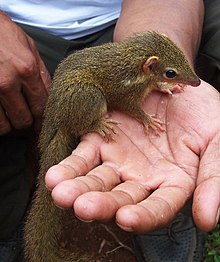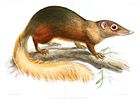
The treeshrews are small mammals native to the tropical forests of South and Southeast Asia. They make up the entire order Scandentia, which split into two families: the Tupaiidae, and the Ptilocercidae.

The Madras treeshrew, also known as the Indian treeshrew, is a species of treeshrew in the monotypic genus Anathana found in the hill forests of central and southern India. The genus name is derived from the Tamil name of moongil anathaan and the species name is after Sir Walter Elliot of the Indian Civil Services in Madras.
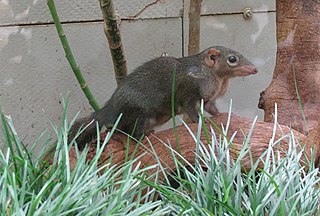
The northern treeshrew is a treeshrew species native to Southeast Asia.
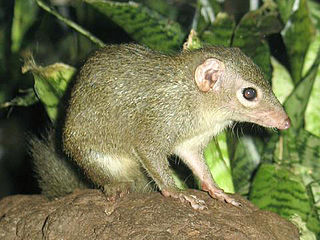
The common treeshrew is a small mammal in the treeshrew family Tupaiidae, and is native to Thailand, Malaysia, and Indonesia. It has been listed as Least Concern by IUCN as it remains common and displays some adaptability to ongoing habitat loss.

The northern smooth-tailed treeshrew is a species of treeshrew in the family Tupaiidae found in Cambodia, Thailand, and Vietnam. Their diet primarily consists of invertebrates but rarely includes fruits and plants.

The pen-tailed treeshrew is a treeshrew of the family Ptilocercidae native to southern Thailand, the Malay Peninsula, Borneo, and some Indonesian islands.

The golden-bellied treeshrew is a treeshrew species within the Tupaiidae. It is also called Mentawai treeshrew as it is endemic to the Indonesian Mentawai islands of Sipora, North and South Pagai. It lives in forests, and is considered endangered due to habitat loss since the islands' forests are continuously logged.
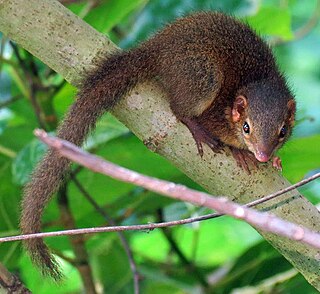
Horsfield's treeshrew, also called Javan treeshrew, is a treeshrew species within the Tupaiidae. It is endemic to the Indonesian islands of Sumatra, Bali, Java and Nias where it inhabits foremost primary forest.
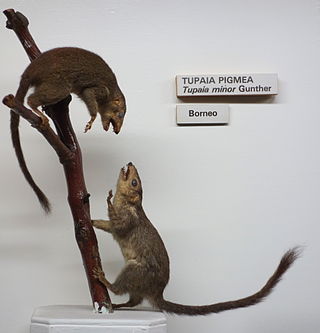
The pygmy treeshrew is a treeshrew species within the family Tupaiidae. It is native to Thailand, Malaysia and Indonesia. The generic name is derived from the Malay word tupai meaning squirrel or small animals that resemble squirrels.

The mountain treeshrew is a treeshrew species within the Tupaiidae. It is endemic to Borneo and inhabits montane forests in Sarawak and Sabah, Malaysia, and Kalimantan, Indonesia.

The painted treeshrew is a treeshrew species of the family Tupaiidae.

The large treeshrew is a treeshrew species within the Tupaiidae. It is native to Sumatra and adjacent small islands, as well as in the lowlands and hills of Borneo.

The Mindanao treeshrew, also called the Philippine tree shrew, is a species of treeshrew endemic to the Mindanao region in the Philippines. It was formerly considered the only member of the genus Urogale, but that genus was merged into Tupaia when the species was found to nest within the latter genus in a molecular phylogeny. The scientific name commemorates British colonial administrator and zoological collector Alfred Hart Everett.

Tupaia is a treeshrew genus in the family Tupaiidae that was first described by Thomas Stamford Raffles in 1821. The name of this genus derives from the Malay word tupai meaning squirrel or small animal resembling a squirrel.
Tupaia miocenica is a fossil treeshrew from the Miocene of Thailand. Known only from a single tooth, an upper first or second molar, it is among the few known fossil treeshrews. With a length of 3.57 mm, the tooth is large for a treeshrew. At the back lingual corner, the tooth shows a small cusp, the hypocone, that is separated from the protocone in front of it by a narrow valley. The condition of the hypocone distinguishes this species from various other treeshrews. In addition, the presence of a well-developed but simple mesostyle is distinctive.
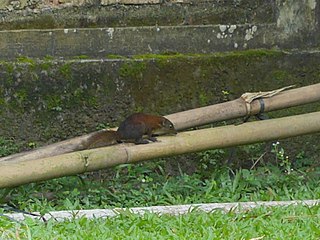
The Sumatran treeshrew is a treeshrew species within the Tupaiidae family. It was previously listed as a subspecies of Tupaia glis for one hundred years, but was raised up to species status in 2013. It is found on the islands of Sumatra and Tanahbala in Indonesia. It is the type species for the Tupaia genus.
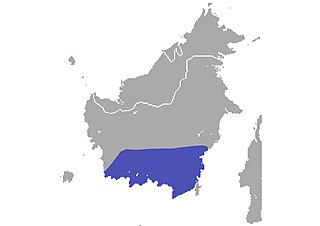
The Kalimantan treeshrew or southern large-footed treeshrew is a treeshrew species within the Tupaiidae family. It was originally described as a subspecies of Tupaia longipes and later listed as a junior synonym of Tupaia glis, before being returned to its subspecies status. It was raised up to species status in 2013. It is found on southern portion of the island of Borneo in Indonesia.
